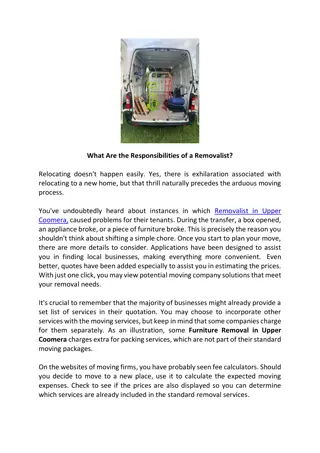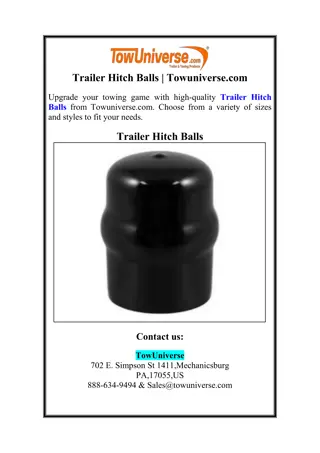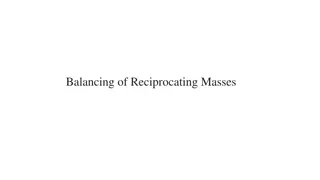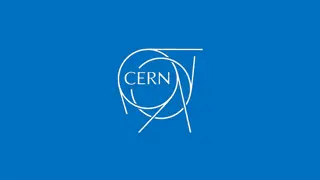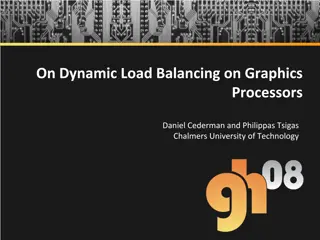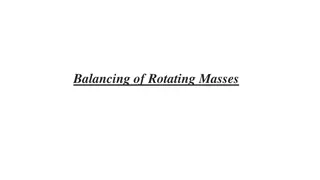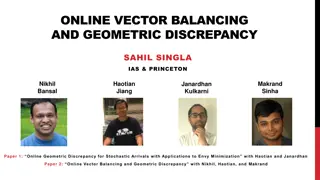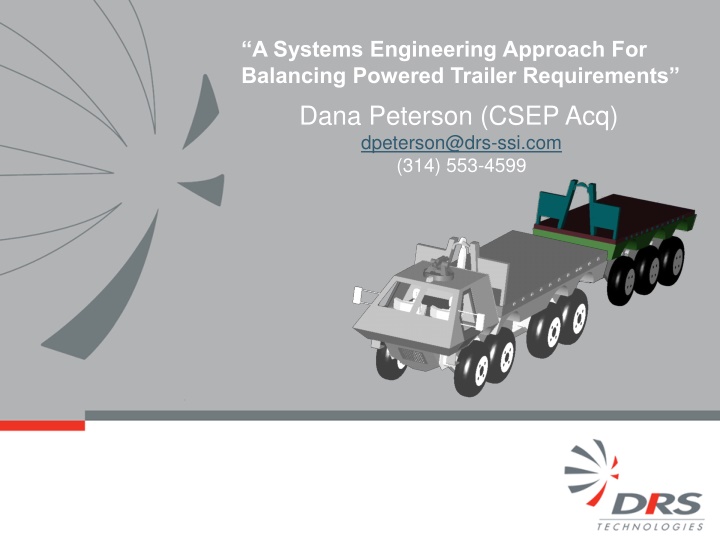
Systems Engineering Approach for Power Trailer Requirements Balancing
This presentation by Dana Peterson focuses on using systems engineering tools to balance requirements for a powered trailer project. It covers resolving requirement issues, understanding relationships between requirements, and prioritizing the best technology options for a balanced solution. The project goals include improving truck and trailer mobility, providing cargo reporting, and enabling trailer self-mobility. Various tools like Requirements Traceability Matrix and Analytic Hierarchy Process are utilized for requirement prioritization and technology selection.
Download Presentation

Please find below an Image/Link to download the presentation.
The content on the website is provided AS IS for your information and personal use only. It may not be sold, licensed, or shared on other websites without obtaining consent from the author. If you encounter any issues during the download, it is possible that the publisher has removed the file from their server.
You are allowed to download the files provided on this website for personal or commercial use, subject to the condition that they are used lawfully. All files are the property of their respective owners.
The content on the website is provided AS IS for your information and personal use only. It may not be sold, licensed, or shared on other websites without obtaining consent from the author.
E N D
Presentation Transcript
A Systems Engineering Approach For Balancing Powered Trailer Requirements Dana Peterson (CSEP Acq) dpeterson@drs-ssi.com (314) 553-4599
Purpose of Presentation Illustrate a sample of Systems Engineering tools used on the Powered Trailer project to: Resolve requirement issues Understand relationships between requirements Prioritize requirements Get consensus on the best technology options Provide the best balanced overall solution INCOSE BRIEF @ DRS Technologies 2
Powered Trailer Project Goals Powered Trailer Improve combined truck and trailer grade climbing and mobility in soft soil terrain conditions Provide cargo and health status reporting over the C4I network Provide limited trailer self-mobility for climbing aircraft/ship ramps under operator control Provide on-board DC/AC export power for powering shelters and other equipment Focus is on Trailer Drive Technologies INCOSE BRIEF @ DRS Technologies 3
Sample SE Tools Requirements Traceability/ Rationale Matrix (RTRM) N2 Diagram Analytic Hierarchy Process (AHP) Quality Function Deployment (QFD) Morphological Analysis (MA) Architecture Views Trade Study Sensitivity Analysis Affinity Diagram Tree Diagram Fishbone Diagram Digraph Blueprinting Arrow Diagram Matrix Diagram Relations Diagram Process Decision Program Chart Flow Diagram Context Diagram Pugh Matrix Specification INCOSE BRIEF @ DRS Technologies 4
Systems Engineering Approach Requirements Traceability/ Rationale Matrix (RTRM) Requirement Prioritization QFDHouse Of Quality Performance Spec User Requirements AHP MA Technology Options Mobility Analysis Power Trailer Design Alternatives Trade Studies -Performance -Payload -C-130 Transport -R&M -Cost -Schedule Legend AHP = Analytical Hierarchy Process QFD = Quality Function Deployment MA = Morphological Analysis Sensitivity Analysis Preferred Solution An Iterative Hierarchical Process That Provides the Best Overall Requirements Balance
Multi-Attribute Criteria Problem Many requirements in diverse functional areas A lot of stakeholders involved Tools are needed to balance requirements and validate concept prior to project execution Cost and schedule are receiving a lot more attention Performance INCOSE BRIEF @ DRS Technologies 6
Solution Synthesis is Becoming More Challenging Part Obsolescence Technology Advances Reorganization Cultural Robust Design Techniques Design for Adaptability Economic Spiral Development Rapid Response Open Architecture Six Sigma Security Modular Systems Approach Agile Design Political Performance Design To Cost People Resources Design for Dynamic Value Company Mergers Eco-Consciousness INCOSE BRIEF @ DRS Technologies 7
Customers Now: Prioritizing Requirements: Spiral 1, 2, 3 Evolution Threshold Vs Objective Key Performance Parameters Vs Key System Attributes Vs Additional Attributes Tier Levels 1, 2, 3, 4 Asking: What Is Possible? What Can Be Done Within Program Constraints and Current Technology? What Are The Tradeoffs? Provide Me With The Best Balanced Solution! INCOSE BRIEF @ DRS Technologies 8
RTRM Sample Sheet (Transport & Trailer Requirements) POWERED TRAILER REQUIREMENTS TRACEABILITY/RATIONALE MATRIX (RTRM) Draft Trailer Requirement based on FTTS ORD unless specified otherwise Item Reqmt/Short Description 78 30% Side Slope Source Comments/Requirements Rationale Spiral 1 Spiral 2 Spiral 3 Prod Derived from ORD lines 300 - 304 The MSV at GCW must negotiate the 30% side slope. The companion trailer is assumed coupled to the truck. This requirement must be met with either side of the vehicle facing uphill. At what speed does this need to be meet? Definitely need to check stability The Mobility Rating Speed (MSR) and the Percent Go/No Go in soft soil for the MSV must be equal to or greater than the FCS vehicle. Therefore, the trailer should provide equal performance. We need to determine what the FCS requirement is. The FTTS-MSV from CW to GCW shall be capable of traversing a dry hard surface side slope up to and including 30 percent. Side slope operation shall be performed with either side of the vehicle facing up slope and without loss of stability or malfunction x 79 Soft Soil Mobility equal to or greater than FCS Derived from ORD lines 308 - 309 Soft Soil Traversing Characteristics. The FTTS-MSV (with companion trailer) shall have equal or better Mobility Rating Speed (MRS) and percent GO/NO-GO than the FCS. x 80 Central Tire Inflation System (CTIS) ORD lines 329 - 337 The requirement is to be able to adjust the MSV/trailer tire pressures to improve cross country mobility. The range of parameters that must be considered are GVW to GCW, axle locations, and terrain conditions. 109.62 inches raised (24 inch ground clearance) and 94.62 inches squatted (9 inch ground clearance). FTTS is 374.5 inches long and has a 96 inch width, with a 77 inch track? Note that these dimensions are subject to change. Statistics: - Number of Requirement Paragraphs: - Number of Stated Requirements: 250 - Requirements Needing Clarification: 20 (8%) - Number of Requirement Disconnects: 12 (5%) Total Requirement Issues: The FTTS MSV and its companion trailer shall incorporate means to adjust tire pressure to increase cross country mobility. The FTTS-MSV shall incorporate this capability to allow the operator to adjust tire pressure. x 81 FTTS will have variable height Program charts Dimensions do not apply to the companion trailer, these are dimensions and requirements for the FTTS prime mover. Variable height may however be required for the trailer to meet transport requirements. x 135 32 (13%) RTRM Helps To Identify & Resolve Requirement Issues INCOSE BRIEF @ DRS Technologies 9
System N2 Diagram The N2 diagramillustrates interfaces and relationships between system requirements, parameters, and metrics System functions or elements are listed in the diagonal boxes Interfaces and relationships are identified in the off-diagonal boxes. Data flows in a clockwise direction between functions or elements The next example illustrates a modified form of N2 where requirements have been listed in the diagonal boxes Helps To Surface Interface Issues N2 Helps To Identify Interface Issues INCOSE BRIEF @ DRS Technologies 10
Example N2 Diagram Mobility Payload Protection Transportability C4ISR/EW Elec Power Supportability GVW Curb Weight Height Mobility %NO-GO <25 45-50 mph on 5% Grade Payload: GVW- CW- Crew 24 Ground Clearance Desired Turning Radius of 25 SA (FBCB2, MTS) Engine Gen/ Alternator Fuel Specifics Diesel 80 gm/kWh JP8 88 gm/kWh Pwr to Weight Ratio > 30 bhp/ton See GVW t/2h 1.20 for Stability Payload Suspension Max Payload at 5100 lbs Weight Trades Essential Combat Configuration (ECC) C2 Equip Med Equip Weight Trades Sustainment Supplies for 3 Days Weight Trades Payload to Curb Weight Ratio 0.5 H=76 for MPF 102 C-130 Protection Protection for Crew Vs. Weight KE, MINE, IED, Overhead Ease of B-Kit Armor R/R Threat Types & Locations Active Armor Protection Armor Repair Costs Weight Trades Integral Armor GPK, CROWS, Weapons Transportability (2) C-130, CH-47, CH-53, MPF Operator Remote Control Climbing Ramps Trailers 18,000 lbs (2) On C-130 12,000 lbs Desired H=76 for MPF 102 C-130 C4ISR/EW Obstacle Avoidance Net-ready, C2, FBCB2, MTS Silent Watch (2 Hours) RFID C2 Equip Weight C2 Antennas Equipmen t Weight Elec Power Hybrid Drive Option 15 kW OB 10 kW Exp Exp Power Weight Trades A-Kit Vs B-Kit Supportability Fuel Stowage Items BII Health Mgt. CBM+ A0=95% MMBF=10,000 for Production Efficiency 60 ton-mpg 400 mile range GVW Acceleration 13,000 lbs Max. Axel Loading Not GVW: CW + Payload + Crew Height Impacts Weight Specified Curb Weight Weight Trades Weight Trades 13,000 lbs Max. Axel Loading Not Height Impacts Weight Specified Height Suspension < 157.5 for Berne Tunnel
Analytical Hierarchy Process (AHP) Proven, effective means to deal with complex decision making involving multiple criteria Captures both subjective and objective evaluation measures A hierarchal decomposition of requirements or goals is accomplished Pair wise comparisons of requirement attributes are made and relative scores computed for each leaf of the hierarchy Scores are then synthesized yielding the relative weights at each leaf as well as for the overall model A coherent assessment is reached when Inconsistency Ratio < 0.1 (http://people.revoledu.com/kardi/tutorial/AHP/Consistency.htm) AHP Helps to Determine Relative Importance INCOSE BRIEF @ DRS Technologies 12
Requirements Model Breakdown Model Level 1 Power Mobility Transportability Survivability C4IRS/EW Supportability Payload Management GVW Driver Vision Stability Speed HP/ton Operational Range CW Height 76in Axle Loading 30 min Ready CREW2.1 SD Weapon CBRNE Signature Mgt Ballistics Protection C3 SA Net Security Bus Architect Power Buses OB Power Export Power Electrical Storage RAM Health Mgt HFE O&S Cost Commonality Flatrack (3,200 lb) Cargo (22,000 lb) Model Level 2 Fuel efficiency (ton-mpg) Fuel Capacity Armor Protection LVOSS Visual signature Thermal signature EM signature Direct Fire IED Mine Anti-tank Blast Protection Seats Crush resistant roof Model Level 3 Fuel Specifics ECU Map Model Level 4 Legend: GWV =Gross Vehicle Weight, CW = Curb Weight, C3 = Command, Control, Communications, SD = Self-Defense, SA = Situational Awareness, OB = On- Board, DVE = Driver Vision Enhancer, CBRNE = Chemical, Biological, Radiological, Nuclear Effects, IED =Improvised Explosive Device, LVOSS = Light Vehicle Obscuration Smoke System, LCC = Life Cycle Cost, UPC = Unit Production Cost INCOSE BRIEF @ DRS Technologies 13
Analytical Hierarchy Process Snapshot Combinatorial Trade Study- Requirements Importance Level 1 Requirements Per Customer Attribute Weights (weights can be modified for tradeoff purposes) Mobility 0.14 Payload 0.20 Transportability 0.20 Survivability 0.10 C4ISR/EW 0.13 Power Mgt 0.07 Supportability 0.16 Total 1.00 If Row and Column are of equal importance then 1; minimize use of 1 If Row more important than Column then 2 If Column more important than Row then 0 Only need to assess White pairs; Gray pairs are diagonal or self-calculated Level 2 Requirements- Mobility GVW Driver Vision GVW 1 0 Drive Vision 2 1 Roll Stability 2 1 Top Speed 0 0 Hp/ton 2 1 Operating Range 2 0 Notes: Roll Stability Top Speed Hp/ton Operating Range Weighting Normalized 0.083 0.250 0.278 0.028 0.194 0.167 Global 0 1 1 0 0 0 2 2 2 1 2 2 0 1 2 0 1 1 0 2 2 0 1 1 3 9 10 1 7 6 36 0.012 0.035 0.039 0.004 0.027 0.023 0.140 Totals 1 Level 3 Requirements- Operating Range Fuel Efficiency Fuel Capacity Armor Protection Weighting Normalized 0.333 0.556 0.111 1.000 Global Fuel Efficiency Fuel Capacity Armor Protection 1 2 0 0 1 0 2 2 1 3 5 1 9 0.0078 0.0130 0.0026 0.023 Totals Level 4 Requirements- Fuel Efficiency Fuel Specifics ECU Map Weighting Normalized 0.750 0.250 Global Fuel Specifics ECU Map 1 0 2 1 3 1 4 0.0058 0.0019 0.0078 Totals 1 INCOSE BRIEF @ DRS Technologies 14
Quality Function Deployment (QFD) There are many customers There are stated and unstated requirements QFD helps to prioritize requirements and their tradeoffs QFD makes invisible requirements and strategic advantages visible QFD helps to define which improvements provide the most gain QFD promotes Team Consensus QFD provides a documented audit trail for decisions The House of Quality Captures the Voice of the Customer INCOSE BRIEF @ DRS Technologies 15
House of Quality Interrelationships between Technologies Requirements/Desires (Voice of the Customer) Technologies (Voice of the Company) Planning Matrix -Requirements Importance -Percent Improvement Desired -Marketing Competition Assessment Relationships between Requirements and Technologies Prioritized Technologies INCOSE BRIEF @ DRS Technologies 16
Powered Trailer QFD Analysis Two meetings were conducted with shareholders to get consensus on the Powered Trailer House of Quality Body of Matrix Common definition/scope for each requirement and technical attribute agreed to Reinforced relationship values - by convention: (0-none, 1-weak, 3-moderate, 9-strong) Recognized the most important associations Segregated positive and negative correlations, ensured they were mutually exclusive Achieved Consensus, Consensus, Consensus QFD was finalized via (2) additional WebEx conferences INCOSE BRIEF @ DRS Technologies 17
Powered Trailer House of Quality + - + + - DIRECTION OF MOVEMENT Technology Areas Propulsion Power Mgt & Control Remote Operations Suspension Axles Steering Braking Cargo Handling Survivability Storage Tech. Diagnostics/Prognostics PLANNING MATRIX Adjustable Height deck Configued Load SW Auto ID Technology Standard serial bus Overall Weighting Customer Importance Customer Importance Hybrid Propulsion Improvement Factor None-towed only Percentage of Total Mechanical PTO Dual Vs 3 Axles Applique armour Smart tie down Power Storage Cargo Tagging Signature mgt. Intelligent LHS Wireless (RF) Electric PTO Suspension Thermostat Continuous Umbilical ICE only Steering Sensors Variable Braking MIP Trailer Requirements PERFORMANCE Maximize payload Dash speed (deleted) Minimize turning radius Step up vertical obstacle Fording Cross trenches 60% longitudinal slope 30% side slope Transportability - via surface Transportability - via air No mobility degradation Range (fuel economy) Self-charging system Pwr & control from truck Trailer has own brakes Trailer provides export pwr Enhanced survivability Communicate with truck "FTTS" Prime Mover Interoperability "Current" Prime Mover Interoperability Interface with flatracks/cargo Auto self fuel O&S COST RELATED Maintenance Ratio 0.025 On-board fluid analysis Embedded diag/prognostics Fault isolation (deleted) Configuration Commonality Min.storage system maint. (deleted) Reliability ENVIRONMENTAL (Temp/EMI/Vib/Shock/Corrosion) 4 1 1 3 9 1 9 3 1 4 0 3 2 4 3 4 4 5 5 5 5 2 3 5 2 2 5 5 3 5 1 1.00 0.00 1.50 1.50 1.15 1.30 1.25 1.00 1.50 1.20 2.00 1.30 1.00 1.25 1.00 1.25 1.20 1.30 1.00 1.10 1.25 1.10 4 0 3.1 0 3 2 4 3 4 4 5 5 5 5 2 3 5 2 2 5 5 3 5 1 3 9 3 9 9 4.5 3 4.6 3.9 5 4 7.5 6 10 6.5 2 3.8 5 2.5 2.4 6.5 5 3.3 6.3 1.1 3.5 2.3 3.6 3 1 3 9 3 1 3 9 3 9 3 9 9 3.9 3.1 5.8 4.6 7.7 9 3 9 9 3 3 9 9 9 3 9 9 3 3 3 3 1 3 3 9 9 3 9 9 1 9 3 3 5 1.5 2.9 3.9 1.9 1.9 1 1 3 3 9 9 3 9 3 1 9 3 9 9 9 3 1 1 9 9 3 1 9 3 3 9 9 9 5 9 9 3 9 3 9 3 3 1 3 3 1 3 1 3 3 1 1 3 9 3.9 2.6 4.8 0.9 9 9 9 9 9 9 5 3 5 9 3 3 1 1 1 1 1 1 1 1 9 1 9 3 3 9 9 1 1 9 1 1 9 1 9 9 5 3 5 0 4 0 5 1.40 1.10 1.20 0.00 1.25 0.00 1.20 7 5.4 2.6 4.6 3.3 6 0 5 0 6 1 0 4 3 3 3 3 3 3 3 3 3 3 3 3 3 3 3 3 3 3 3 3 9 9 9 3.9 0 5 9 3 3 1 1 3 1 9 3 9 3 3 3 1 9 3 3 9 4.6 4 9 3 1 3 1 1 1 4 1.30 5.2 4 TECHNICAL DIFFICULTY(TD) TD Normalized COST FACTOR Cost Factor Normalized 3 2 2 1 2 2 2 1 1 2 2 2 2 2 2 2 2 2 2 2 2 1 2 2 2 1 129 100 1.5 3 1.5 1.0 1.0 0.5 2 2 1.0 1.0 0.5 1.0 2 1.0 1.0 2 1.0 1.0 2 1.0 0.5 2 1.0 0.5 1 0.5 1.0 2 1.0 1.0 2 1.0 1.0 1 0.5 1.0 2 1.0 1.0 2 1.0 1.0 2 1.0 1.0 1 0.5 1.0 1 0.5 1.0 2 1.0 1.0 2 1.0 1.0 2 1.0 1.0 1 0.5 0.5 2 1.0 1.0 3 1.5 1.0 1.0 2 1.0 1.0 0.5 1 0.5 1 2 504 12.7 1.9 2.4 2.2 73 95 89 354 9.0 0 90 2.3 45 1.1 39 1.0 150 3.8 469 11.8 75 1.9 237 6.0 323 8.2 125 3.2 77 2.0 110 2.8 15 0.4 33 0.8 80 2.0 11 0.3 29 0.7 489 12.4 186 197 4.7 5.0 63 1.6 3959 100 TECHNOLOGY PRIORITIES PERCENTAGE OF TOTAL 0.0
Powered Trailer House of Quality INCOSE BRIEF @ DRS Technologies 19
QFD Relative Ranking 100 Suspension ICE Hybrid Braking Pwr Storage Steering Towed LHS Serial Bus Auto ID Adj. Deck 3 Axles Umbilical MIP Elect PTO Smart Tie Mech PTO Signature Mgt Wireless 90 80 70 60 50 40 30 20 10 0 QFD Relative Ranking (Excludes Technical Difficulty and Cost Factors) INCOSE BRIEF @ DRS Technologies 20
Arrows Impossibility Theorem (A Word of Caution!) Combining individual preferences to form a group utility function presents a problem The use of averaged group preference data in product design optimization can lead to erroneous results This problem may not always be self- evident in the analysis of complex systems and products Group Consensus Must Be Reached To Avoid This Problem Provides a Hierarchical Model For Doing Tradeoffs INCOSE BRIEF @ DRS Technologies 21
Morphological Analysis Designed for multi-dimensional, non- quantifiable problem complexes Explores boundary conditions Investigates the total set of possible relationships and configuration alternatives Rules out alternatives that are inconsistent or incompatible using cross-consistency assessment MA Ensures No Alternative is Overlooked INCOSE BRIEF @ DRS Technologies 22
Morphological Field Example: 3-Parameters: color, texture, size Color: 5 discrete values: red, green, blue, yellow, brown Texture: 5 discrete values: smooth, serrated, rough, grainy, bumpy Size: 3 discrete values: large, medium, small 75 cells or configurations (Zwicky, 1969, p. 118.) INCOSE BRIEF @ DRS Technologies 23
MA-Trailer Drive Alternatives Vehicle Output Energy Form Mechanical Trailer Drive Type No. Vehicle Output Energy Form Trailer Drive Consistency? YES/NO 1 Mechanical Mechanical YES Mechanical 2 Mechanical Electrical NO 3 Mechanical Hydraulic NO Electrical Electrical 4 Mechanical ICE NO Hydraulic Hydraulic 5 Electrical Mechanical NO 6 Electrical Electrical YES None Internal Combustion Engine (ICE) 7 Electrical Hydraulic NO 8 Electrical ICE NO Hybrid Electric 9 Hydraulic Mechanical NO 10 Hydraulic Electrical NO Hybrid Hydraulic 11 Hydraulic Hydraulic NO 12 Hydraulic ICE NO Number of Configurations or Alternatives 4 X 6 = 24 13 None Mechanical NO 14 None Electrical NO Ruled out Combinations of Output Energy and Hybrid 3 X 2 = 06 15 None Hydraulic NO 16 None ICE YES 18 Alternatives to Investigate 17 None Hybrid Electric YES 18 None Hybrid Hydraulic YES (5) Drive Alternatives Remain in Trade Space INCOSE BRIEF @ DRS Technologies 24
Powered Trailer Design Concepts ALT #1 Electric PTO -Electrical Power Take Off provided by the transport ALT #2 HEV -Series Hybrid Electric Vehicle with ICE, generator, and battery pack ALT #3 HHV -Hybrid Hydraulic Vehicle with hydraulic power provided by an ICE driven power pack ALT #4 Mechanical PTO -Mechanical Power Take Off provided by the transport ALT #5 ICE Drive -ICE (210 HP with 340 ft-lb torque) with conventional drive train ICE = Internal Combustion Engine INCOSE BRIEF @ DRS Technologies 25
Features Common To All Concepts 395/85 R20 XZL tires Central Tire Inflation System (CTIS) Pneumatic Anti-Lock Brake System (ABS) Serial communications with transport Control of mobility assist and CTIS Receipt of trailer health and cargo load status Independent Suspension Trailer bed basic design INCOSE BRIEF @ DRS Technologies 26
Concepts ALT #1 Elect PTO ALT #2 HEV Trailer Trailer pneumatic discrete pneumatic discrete Battery Pack 36 kW-hr (25) 120 amp-hr batteries Steering actuator Battery Pack 36 kW-hr (25) 120 amp-hr batteries fuel tank Steering actuator Generator ICE Air tanks serial motor Air tanks serial ABS motor ABS mechanical Control box/Inverter motor mechanical Control box/Inverter Transport Control box/Inverter Transport Control box/Inverter Display Display CTIS motor 200 Kw 300 vdc pump CTIS pump System Controller DC-AC Inverter radiator System Controller DC-AC Inverter radiator 12/24 vdc for electronics, trailer lights, etc. 12/24 vdc for electronics, trailer lights, etc. Export Power Export Power Operator Remote Control Unit Operator Remote Control Unit Note: Brake and CTIS lines not shown for clarity Note: Brake and CTIS lines not shown for clarity ALT #4 Mech PTO ALT #3 HHV Trailer pneumatic Trailer pneumatic discrete Pump/ motor discrete ICE serial ABS serial Transport Low pressure reservoir ABS mechanical Transport mechanical PTO Display Display Display High pressure accumulator System Controller hydraulic Display System Controller 12/24 vdc for electronics, trailer lights,etc. 12/24 vdc for electronics, trailer lights,etc. Note: Brake and CTIS lines to wheels not shown for clarity Operator Remote Control Unit ALT #5 ICE Drive Note: Brake and CTIS lines to wheels not shown for clarity Trailer pneumatic discrete Generator ICE CVT Architectural Views for all Five Alternatives serial ABS Transport mechanical Fuel Tank Display Display System Controller DC-AC Inverter 12/24 vdc for electronics, trailer lights,etc. Export Power Operator Remote Control Unit Note: Brake and CTIS lines to wheels not shown for clarity INCOSE BRIEF @ DRS Technologies 27
Physical Characteristics ALT#1 Electric PTO 4 x 2 Double A-Arm Double A-Arm 280 96 51.5 18 81 192 5,745 ALT#2 HEV ALT#3 HHV ALT#4 Mech PTO 4 x 2 Either Type 280 96 51.5 18 81 192 5,745 ALT#5 ICE drive Wheel Drive Suspension Length (in) Width (in) Deck Height (in) Ground Clearance (in) Track (in) Wheel Base (in) Basic Bed (lbs) Suspension & Power Drive (lbs) Flat rack (lbs) Cargo Load (lbs) Total Weigh-lbs ST = Short Ton or 2,000 lbs 4 x 4 4 x 2 4 x 4 Trailing Arm 285 96 51.5 18 79 201 5,745 Either Type 328 96 51.5 18 81 192 5,745 328 96 51.5 18 81 192 5,745 6,625 9,800 5,155 4,875 7,570 3,200 3,200 3,200 3,200 3,200 22,000 22,000 22,000 22,000 22,000 37,570 18.8 ST 40,395 20.2 ST 36,100 18.1 ST 35,820 18 ST 38,515 19.3 ST INCOSE BRIEF @ DRS Technologies 28
ALT #1 Elect PTO Components Detail Needed for Credible Cost & Schedule Estimates INCOSE BRIEF @ DRS Technologies 29
Cost Vs Key Requirements Met Cost Vs Key Requirements Met $150K HHV 85 $140K HEV 95 per 1000 Units $70K ICE 85 Cost $55K Elec PTO 75 $40K Mech PTO 60 $35K Basic 45 0 10 20 30 40 50 60 70 80 90 100 Percent of Key Requirements Met INCOSE BRIEF @ DRS Technologies 30
Comparison of Alternatives Trade Parameters Requirement Weightings Alt #1 Elect PTO Alt #2 HEV Alt #3 HHV Alt #4 Mech PTO Alt #5 ICE Drive Mobility Assist 5 | 5 3 5 4 3 5 Self Mobility 3 | 3 0 5 4 0 4 Payload 4 | 4 5 4 4 5 4 Complexity (RAM) 2 | 4 4 2 2 5 3 Interoperability 4 | 4 3 4 1 2 4 Maturity 2 | 4 4 3 2 5 5 Commonality 3 | 2 4 4 1 1 2 Unit Prod Cost 4 | 4 4 1 1 5 3 Weighted Score 91 |103 98 |104 67 | 74 86 |105 103 |117 Normalized Score 1.36 |1.39 1.46 |1.41 1 | 1 1.28 |1.42 1.54 |1.58 Weighting/Scoring 0-5 with 5 Best INCOSE BRIEF @ DRS Technologies 31
SE Tool Usage Summary Understanding requirements; their relationships, and relative importance: Tools: RTRM, N2 Diagram, AHP Getting consensus on the best technology options for meeting customer needs: Tools: QFD (House of Quality) Evaluating alternatives: Tools: AHP, MA, Architectural Views Selecting the best alternative: Tools: Trade Study, Sensitivity Analysis INCOSE BRIEF @ DRS Technologies 32
Conclusions SE Process Critical for Providing Best Balanced Solution SE Tools Assist in: Understanding requirements and their relationships Getting consensus on which technology options provide the greatest benefits Assuring no viable alternative is overlooked Performing meaningful tradeoffs and sensitivity analysis Making decisions involving multiple attribute criteria Go to: www.incose.org for more information Capturing the Results in the Requirements Set Reduces Program Execution Risks INCOSE BRIEF @ DRS Technologies 33
Questions ? INCOSE BRIEF @ DRS Technologies 34


